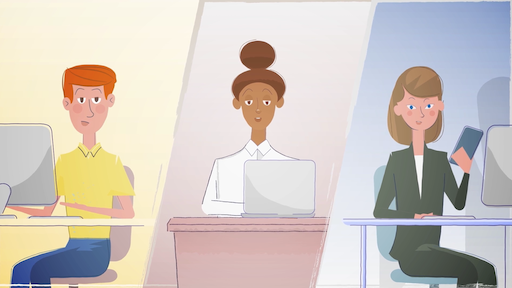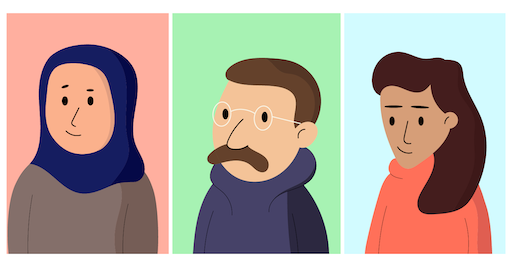3 The meaning of community in social media
Social media includes an ever expanding range of different websites and apps. All of these have different functions. Each platform has a different set of features that allows users to engage with each other in different ways – this has led to platforms offering users a variety of functions. In the next activity, you will consider some of these.
Activity 2 the 3 Cs in social media
Watch this video and list the three ways in which social media can be useful in creating a sense of belonging to the student community. Using the ideas in the animation, consider how this can be used to create a goal for your social media use.

Transcript: Video 2 Using digital tools in education
Social media is a huge part of higher education now. But how can you make it work for you? Well, one way is to closely consider your goals for using social media. It might help to focus on the three Cs: connection, collaboration, and communication.
Connection. Social media can help you to connect with the student community. It’s a way to build your network of peers who are also studying, you can share your learning of key concepts, and discover that of others. It’s also a great way to stay motivated.
If you’re just getting started with social media as part of your educational journey there are ways in which you can use social media to search for information. These include Facebook, Twitter, and Instagram. You will learn more about these in course. Not forgetting, of course, the most popular platform with students is most probably WhatsApp.
WhatsApp is a dynamic platform as it allows many conversations to take place. You can be as active or passive as you like in these groups, from reading the outputs of your peers, to sharing your own publications and news stories, to, of course, engaging in discussion and debate. It’s particularly effective for increasing the visibility of your research, sharing your achievements, and building connections with those in your field.
Collaboration. Social media provides an opportunity for students to collaborate across modules and programs. This collaboration can lead to the creation of personal learning networks, which helps consolidate learning while building a greater sense of community. Social media is also a fantastic means of finding other professionals who are working in the area you are studying in. There’s so much research available on social media that it’s increasingly easy to find academics with similar research interests. Finally, communication.
Communication is the heart of social media. But give some thought to who you are trying to communicate with. Is it other students on your module, your qualification or the wider institution that you attend? Used right, social media will help you connect with your peers in a way that feels relevant and personal.
All you have to do is remember the three Cs.
Comment
The video considers the 3Cs of Connection, Collaboration and Communication as being key to the use of social media as part of educational practices. You need to consider how this can be adapted for your own personal needs in engaging in social media during your studies.
Connection: This can help you to connect with other students directly. It could also be a more individual connection that allows you to build up a small, trusted network of peers who are studying at the same time as you, allowing you to help and discuss topics with eachother.
Collaboration: Social media can allow you to make use of professional networks such as Twitter where you can find developments in your field of study. It can also allow you to ask questions in relation to specific aspects of your course, such as where to find support on referencing.
Communication: Social media tools can allow you to communicate with other students. You can connect to students on your module, across your qualification, or your institution.
Using this framework can help you to focus on your goals in using social media for your studies. For example, your goals may determine who you spend time communicating with. You will learn more about this as you work through this session.
One way of thinking about this is to consider if you’re wanting to connect with fellow students on your module, your degree programme, experts in your field of study, or if you are just wanting to stay connected to your institution. These goals will drive your decisions on which apps you use to connect and how often you need to use them.
To help you see the value of different types of community, next you will learn more about why a sense of community can be important to your studies by exploring three case studies.
Click on the characters tabs below to read how they are using social media to connect as part of their studies.
Activity 3 Applying the 3 Cs to HE
In these examples some of the advantages of using social media in this way are illustrated. In the free response box below, enter one disadvantage of using social media in this way. This can either be based on your personal experience, or your wider knowledge of this.
What are the disadvantages of using Facebook to connect to students?
What are the disadvantages of using Twitter to collaborate with students?
What are the disadvantages of using WhatsApp to communicate to students?
Discussion
People use social media in a variety of ways. There are some advantages to engaging in this way but there are some widely acknowledged disadvantages. Carefully considering the purpose of your use of social media is key to ensuring that your educational journey is supported by its use. Using a framework such as Connection, Collaboration and Communication can help you to give greater thought to what you are using social media in higher education for.
You will explore more about the specific advantages and disadvantages of various social media apps in Session 3. In the next section of Session 2, you will explore the sense of community on social media in more detail.

